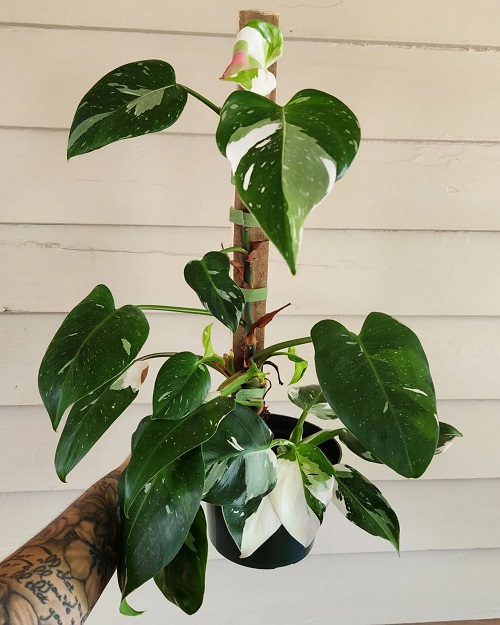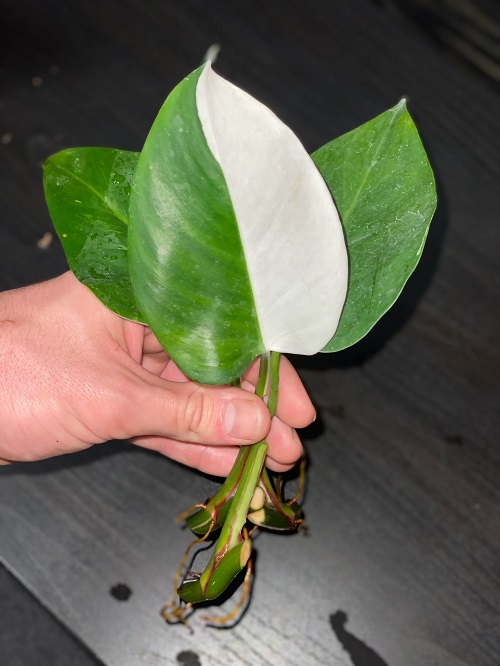Learn the secrets to keeping your indoor White Princess Philodendron everlasting with this comprehensive care guide!

Liven your home with the elegant White Princess Philodendron, a regal beauty that reigns supreme with its gorgeous foliage. It hails from the lush rainforests of Central and South America and can grace your home beautifully under optimal conditions. If you wish to grow this beauty, here’s all you need to know!
- Botanical Name: Philodendron erubescens ‘White Princess’
- Popular as—White Princess Philodendron, Philodendron White Princess
- Attains a height of 3-4 feet indoors
- Loves bright, indirect sunlight
- Thrives in a temperature range of 60 to 85°F (15-29°C)
- Toxic to humans and pets
Click Here to Get the Finest Philodendron Red Anderson Care Guide
What is White Princess Philodendron?
The White Princess Philodendron belonging to the Araceae family, is a tropical houseplant renowned for its regal appearance and elegant foliage. Growing to a height of about 3 feet, it features elongated, heart-shaped foliage in glossy green with captivating patches of white and cream. It is prized for its air-purifying abilities, making it a sought-after indoor plant.
This plant’s allure lies in its enchanting variegation and low-maintenance nature, adding a touch of royalty to any living space.
Discover the Most Colorful Philodendron Varieties here
Philodendron White Princess vs. White Knight
While these Philodendron species may appear similar at a glance, there are several key differences between them:
- Leaf Variegation: White Princess Philodendron typically features green leaves with white or light pink variegation. Whereas white knight often shows more complex variegation patterns, including green, white, and even shades of maroon.
- Stem Color: Philodendron White Princess generally has green stems. At the same time, the White Knight is distinguished by its maroon to dark purple stems, which provide a vivid contrast to its leaves.
- Growth Habit: White Princess grows in a more bush-like, compact form, making it suitable for smaller spaces. However, White Knight tends to be more vining and may require more room to spread, often benefiting from a support structure.
- Foliage Size: The leaves of White Princess Philodendron are generally smaller, ranging from 4 to 6 inches in length. Whereas the White Knight Philodendron foliage is typically larger, often reaching lengths of 8 inches or more.
- Growth Rate: White Princess tends to grow more slowly, particularly if it has a high degree of variegation. White Knight usually grows moderate to fast, depending on the growing conditions.
Ideal Pot Size
The ideal pot size for a White Princess Philodendron depends on the plant’s size, with a general rule of choosing a pot 1-2 inches larger in diameter than its current nursery pot or root ball. Pots with 4-6 inches in diameter are suitable for small-sized plants, while medium-sized plants require 6-8 inches, and larger, more established ones need 8 inches pots or more.
Proper drainage is crucial, so ensure to drill ample holes in the pot.
White Princess Philodendron Propagation

White Princess Philodendron can be propagated through several propagation techniques, such as stem cuttings, air layering, and division. However, stem cutting propagation ensures successful plant multiplication:
- Choose a healthy stem with at least one node and leaf.
- Cut the stem about an inch below the node at a 45-degree angle to increase the surface area for rooting. Ensure to disinfect the shears.
- Fill a pot with well-draining soil or a mix of perlite and peat moss. Ensure the pot has drainage holes.
- Insert the cut end into the soil, ensuring the node is buried at least one inch deep. Tamp the soil around the stem.
- Lightly moisten the soil with water, avoiding oversaturation, and keep the pot in a warm, indirect light area.
Check for root growth in 2-4 weeks by gently tugging the cutting. Resistance indicates root formation. Keep the soil consistently moist until the new plants establish their roots. Once they show signs of new growth, you can treat them like mature White Princess Philodendron plants.
White Princess Philodendron Care
Light
Philodendron White Princess thrives best when it receives 6 to 8 hours of bright, indirect light daily. An ideal location for the plant is near a north or east-facing window where it can benefit from gentle morning or evening sunlight. Although it can adapt to lower light conditions, artificial grow lights can supplement its needs.
Periodic rotation of the plant ensures balanced growth and prevents leaning toward the light source.
Soil
The plant thrives in well-draining soil, allowing excess water to flow easily. Avoid using heavy or compacted soil, leading to waterlogged roots and root rot. It prefers a slightly acidic to neutral pH range between 6.0 to 7.0.
A suitable potting mix for the White Princess Philodendron combines peat moss, perlite or vermiculite, orchid bark, and potting soil in equal parts. This mix provides good aeration and drainage, essential for the plant’s root health.
Water
Watering practices should be adjusted according to the season. During its active growth phase in spring and summer, maintain consistently moist soil by watering when the top inch or two feels dry. However, be mindful to reduce watering frequency in fall and winter when the plant enters dormancy, allowing the soil to dry slightly more between waterings.
Always use room-temperature water and direct it towards the base to minimize the risk of fungal diseases and to keep the foliage dry.
Temperature and Humidity
Temperature-wise, the White Princess Philodendron is comfortable in a range of 65°F to 85°F (18°C to 29°C). It is sensitive to cold drafts and abrupt temperature changes, which could stress the plant and affect leaf health. If temperatures are below 50F or 10C, induce heat lamps or consider nurturing them in an indoor greenhouse.
Mimicking its natural, tropical habitat, the plant prefers higher humidity levels of around 60% or more. You can employ various methods to achieve this, such as using a humidifier, misting the leaves, or placing a water tray nearby.
Fertilizers
For a flourishing White Princess Philodendron, select a balanced, water-soluble fertilizer with an N-P-K ratio like 20-20-20 or 10-10-10. During its growth spurts in the spring and summer, fertilize every 2 to 4 weeks.
When the plant transitions into its dormant phase in the fall and winter, scale back to fertilizing once every 6 to 8 weeks, or cease fertilization.
To apply, dilute the fertilizer to its quarter strength and pour it around the base of the plant during your regular watering routine, ensuring even nutrient distribution in the root zone. Be cautious not to over-fertilize or under-fertilize, as both can stress the plant.
Pro Tip: Adding organic matter, such as well-rotted compost or leaf mold, to the potting mix can improve soil fertility and nutrient availability for the plant.
Pruning
Regular pruning is crucial for the White Princess Philodendron’s well-being. It not only enhances the plant’s appearance but also encourages denser growth and allows you to remove damaged or yellow leaves. Make it a habit to inspect your plant for any signs of damaged, dead, or overcrowded foliage. Utilize clean, sharp pruning tools to make precise cuts just above the leaf nodes, the points from which new growth will sprout.
While pruning can be performed year-round for minor adjustments, significant pruning activities are best scheduled during the active growth months of spring and early summer. This timing allows the plant to quickly recover and channel its energy into new, vibrant growth.
Major Troubleshooting Tips
- Yellowing Leaves: If the lower leaves of your White Princess Philodendron are turning yellow, it may indicate overwatering. Ensure you allow the soil to dry partially between watering sessions to avoid root rot.
- Brown Leaf Tips: Brown, crispy leaf tips can indicate low humidity or excessive fertilization. Consider misting the plant regularly or using a humidifier to maintain optimal humidity. Also, avoid over-fertilizing the plant, as it can lead to nutrient imbalances.
- Pest Infestation: Keep an eye out for common pests like spider mites, aphids, or mealy bugs. If you spot any, isolate the affected plant and treat it promptly with neem oil or insecticidal soap.
- Fungal Issues: Yellow or brown spots on the leaves could indicate fungal problems. Avoid getting water on the leaves, as this can create a conducive environment for fungi to thrive. Maintain good air circulation around the plant to reduce the risk of fungal diseases.
- Pale Leaves: Pale or faded leaves can be a sign of nutrient deficiency. Consider using a balanced, water-soluble fertilizer to give your White Princess Philodendron essential nutrients.
Where To Buy White Princess Philodendron?
Online plant retailers like Amazon and Etsy offer a wide selection of houseplants, including the White Princess Philodendron For Sale. Additionally, local nurseries and garden centers are great places to find this popular houseplant, allowing buyers to inspect the plant’s condition in person before buying.
Plant shows, expos, and botanical events are also worth checking out, as they often feature diverse plant selections for sale. Moreover, plant enthusiasts can explore online forums and social media groups dedicated to houseplants, where some members sell or trade cuttings or young plants, which might include the sought-after Philodendron variety. Always vet the sellers and read reviews to ensure the quality and health of the plant.








